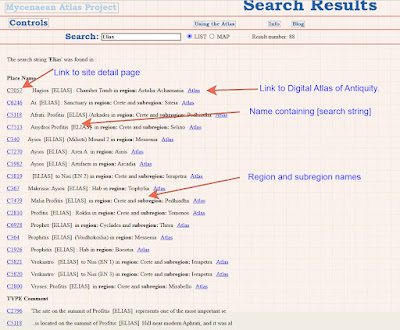The ability to search is a large part of the Mycenaean Atlas. Our search has changed a great deal over the years and so it's time for a new and detailed description.
All the pages in the M.A.P. have a search box. It looks like this:
In the M.A.P. search will do three things:
I. Locate a point on the map
II. Return a list of sites which match a search string
III. Return a map which shows sites that match a search string
I. Locate a point on a map.
If you enter a lat/lon pair separated by a comma then Search returns a map with your input location marked by a cross.
[Map with cross, 37.2, 22.2]
You'll see that this map display also shows a thumbnail map which is zoomed out enough so that you stay oriented about where in the Mediterranean you are. Your current location is indicated by the tiny red diamond icon at the center.
Your search lat/lon pair can also have degree symbols. Those will be ignored. Something like this:
If there are M.A.P. sites or features in the vicinity then those will be shown as well. Here there happens to be a cult site/icon at the center of the map. These icons are also interactive. You can mouse over them or click on them. If you click on one you'll see and info-box which contains a link to the full description of the site or feature.
One limitation is that only M.A.P. sites and/or features are shown. Sites in the other supported DBs like Pleiades or Topostext are not returned in this simple lat/lon search.
This lat/lon search is highly customizable by supplying additional arguments. These (in order!) are as follows:
- Lat
- Lon
- Zoom Level from 2 to 18 (default zoom level is 15)
- Frame size in decimal degrees from 0.01 to 0.30 (the default is 0.15 decimal degrees)
- A frame size of 0.01 is 1.11 km. wide.
- A frame size of 0.30 is 33.4 kilometers wide
- The default frame size of 0.15 decimal degrees is 16.7 kilometers wide.
You must always supply a lat/lon pair but you can also specify the zoom level, framesize, both, or neither.
- Just zoom: nn.nn , nn.nn , z[z]
- Just frame size: nn.nn, nn.nn , , 0.f[f] ----> notice that the comma for the zoom argument is still required.
- Both: nn.nn , nn.nn , z[z] , 0.f[f]
- Neither: nn.nn , nn.nn
nn.nn indicates latitude or longitude values; latitude comes first.
z[z] indicates a 1 or 2 digit zoom integer value from 2 through 18
0.f[f] indicates a frame size from 0.01 to 0.3. This includes such values as 0.08, 0.14, 0.25, etc.
Do not enter html tags or special characters.
II. Return a list of sites which match a search string.
If your search string is NOT in the format lat, lon then the software conducts a traditional search. Here's a search for the string 'Elias'.
If the List radio box is checked then your results will be returned as a list of sites and clickable place keys.
Here is the first page of results returned when we search for 'Elias'.
These returned sites are those which, somewhere in their names or detailed descriptions, contain your search string. The returned list is presented in sections. [In the following list SS stands for 'Search String']
M.A.P. site name.
Find Type Comment
Site Bibliography section title.
The Period section Comment
The site General Note
Feature Name
SS appears in the author name in a bibliography entry
Title or Publisher name of a bibliography entry
Pleiades ID name
Pleiades descriptive label
Topostext site name
deGrauuw's Harbor Name
TrisMegistos Name
Vici.Org Name
D.A.R.E. Name
Each list entry returned gives a link to a detail page for that site, Site Name, String containing the SS (in which the SS appears like this '[SS]' in upper case), and a link to the Digital Atlas which centers the specific matched site.
III. Return a map which shows sites that match a search string
In the Greek-speaking world there are many places which have names based on Hagios Elias. When I search for 'Elias' by list I get 88 results. But which is the one I really want? Perhaps I'm really interested in 'Mar Elias' which is a monastery somewhere in Israel. If we could see all returned results on a map we could quickly sort out the right one. We check off the 'Map' radio button and do the search. The results look like this:
On the map we see that the only 'Elias' in Israel (in all the databases) is the monastery 'Mar Elias' which is in Jerusalem. It happens that the Digital Atlas of the Roman Empire (DARE) has a detailed record about it which you can access from the 'D' icon. In the next picture you see the drop-down menu of the several databases. I have turned them all off except for D.A.R.E.







No comments:
Post a Comment